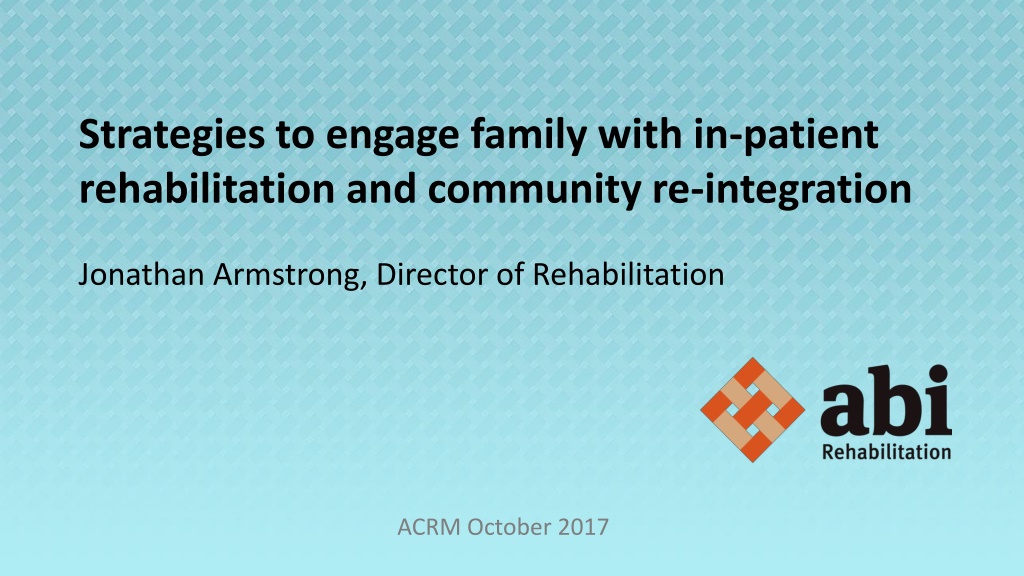Strategies for Family Engagement in Rehabilitation Programs
Engaging family members is crucial for successful post-acute brain injury rehabilitation. In New Zealand, cultural and political considerations highlight the importance of involving families in the rehab process. Evidence supports the positive impact of family engagement on patient outcomes, emphasizing the role of professionals as educators to facilitate understanding and compliance.
Download Presentation

Please find below an Image/Link to download the presentation.
The content on the website is provided AS IS for your information and personal use only. It may not be sold, licensed, or shared on other websites without obtaining consent from the author. Download presentation by click this link. If you encounter any issues during the download, it is possible that the publisher has removed the file from their server.
E N D
Presentation Transcript
Strategies to engage family with in-patient rehabilitation and community re-integration Jonathan Armstrong, Director of Rehabilitation ACRM October 2017
Funding for rehabilitation services Accident Compensation Cooperation (ACC) Provides comprehensive, no-fault personal injury cover for all residents and visitors to New Zealand. One national contract for funding rehabilitation services for moderate-severe brain injuries TBIRR Three national providers of rehabilitation services ACRM October 2017
ABI Rehabilitation: Two sites Auckland & Wellington Covering the North Island and the top of the South Island Approx. 80% of the NZ population ABI Auckland 33 beds ABI Wellington - 17 beds ACRM October 2017
Why family is a focus Cultural Considerations Major cultural groups in New Zealand are Maori, Pacific Islanders and Europeans Maori and Pacific Island cultures family-centric Focus on building relationships with therapists rather than a more patient- practitioner model Maori are over-represented in the TBI population Political Considerations Outcomes for Maori clients are poor compared to European Clients. Vital to engage family in process. Generally lower socio-economic status
Evidence for family engagement A key element for success in post-acute brain injury rehabilitation programs (Evans et al, 2008) Professionals are encouraged to see themselves as teachers and help families learn about brain injury and recovery (Kreutzer et al, 2010) Therapists should address family functioning and family perceptions of patient function to facilitate more favourable patient attitudes regarding program therapies and active patient compliance with therapy activities (Sherer et al, 2007)
Concepts from qualitative research Family bring the real world (context) Family provide the sustainability Family reinforce and provide repetition Provide the client with feedback Provide feedback for the therapist
Therapeutic Alliance Early engagement, cultural needs, listening, joining, education, skills training, community reintegration Client Rehab Team Family
Early Engagement Brain Injury Nurse Specialist in the acute hospitals Their role is to identify and monitor patients in the acute hospital suspected of having a moderate to severe brain injury Therapeutic relationship with family starts here They are the first contact for families coming into our service and provide the families with relevant information They gather history for an IDT handover prior to admission Visits to the ABI site Early goal setting to establish expectations
Meeting cultural needs Maori comprise a disproportionately large percentage of TBI rehab clients Feedback from Maori revealed processes are perceived as medically structured, instead of specifically tailored to the client, whanau or culture Standard cultural safety considerations Recruitment of Kairahi Kopapa Maori (Maori Support Person) Leads a dynamic process of ongoing interaction based on mutual respect, trust, openness and desire to return to good health Karakia, Pepeha, Greetings, Waiata Awareness of Maori Health Models Te Whare Tapa Wha (Durie, 1994) Emerging Maori specific assessments Te Waka Oranga (Elder, 2017) Keeping families together (whanau house)
Actively listening Keyworker s (KW) role is to act as the families link to the rehab team KW is also responsible for reporting to ACC (funder) Goal setting with the rehab program coordinator and client/family Core Team meeting held within first three days of admission to set rehab strategies that match with family/client goal Initial family meetings held within the end of the first week Family have the option of running the meeting how they choose Ongoing family meetings ( Hui ) Make time/space to listen to concerns, hopes, expectations
Joining (active involvement) Family are welcomed into therapy sessions Positively reinforce the client s efforts Witness progress for themselves Decisions are negotiated Steps towards achieving client/family goals were negotiated initially with family and then with the client when they are able to participate in this Families participate in timetabling and rehab activities
Education On brain injury and recovery Written Verbal Pictures Individualised Normalising Managing concerns/fears
Skills training Teaching family specific skills Hoisting Feeding/PEG Self-care Behaviour management Using communication aids Shift of responsibility from rehab provider to family (self- management strategies) Prepare for discharge
Community Reintegration Families are prepared for the client s return to their home and community in a graduated way Outings Day leave Overnight stays Community based rehab activities and groups Trialing strategies in the real world Discharge planning meetings to include community rehab providers
Current community reintegration models The four most commonly cited frameworks: Jacobs (1993) - expert opinion Willer et al (1993) rehab professionals, researchers McColl et al (1998) people with TBI Wong and Soloman (2002) based on literature review More recent work on deriving a framework: Parvaneh and Cocks (2012) practitioners, researchers, policy makers, people with ABI, and their families
Listening Joining To the family s concerns Their experience so far Their plans for the future Their hopes for the client Informal and formal family meetings Welcomed in to therapy sessions Involved in rehab activities Participating in the rehab Seeing the progress being made Positively reinforcing the client s efforts Education/Skills training On brain injury and recovery Psychosocial interventions Normalising Managing concerns/fears Teaching specific skills Shifting responsibility Cultural needs Kiarahi Kopapa Maori Dynamic processes Keep families together Cultural relevant assessment Early engagement Early communication with family in the acute hospital Identifying concerns prior to admission Orientation to rehab facility Family involvement in early goal setting Family/Whanau engaged in rehabilitation Community reintegration Graduated discharge Feedback and revision Real world context


























